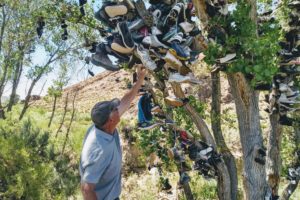Fallon’s local museum, Churchill County Museum, had some wonderful displays of the area. In this post we’ll look at life on trail for the emigrants. We’ll look at the wagons themselves, the supplies they took, their daily life, and their dangers.

The cost of a wagon itself was $60-$90. They were known as Prairie Schooners since they looked like sailing ships as they rode over the flat prairie. Caulked seams and removing the wheels allowed the wagon to float across rivers too deep to cross otherwise.


inside the wagon


Certainly no one rode in the wagons unless sick or injured since there wasn’t space. Imagine walking all 2000+ miles.

supplies

Here’s a more detailed list of what they took. Wonder how much actually made it through to the end of the trip?

No more than 2400 pounds were to be taken in a single wagon, which meant that many families had to take more than one.

Typical day started at 4:00 a.m., and they would travel until dark.

Dangers on the trail, especially the desert, included lack of water, animals dying as they traveled, mirages tempting them to go in a wrong direction, Native Americans frightening them, falls from wagons and serious injuries, snakes and scorpion bites, giant whirlwinds of dust, and rain that turned alkali flats into a stick gumbo that trapped wagons and animals. It’s a miracle that anyone made it to California alive and ready to make a new life.
Everyone had a job.

I can’t imagine what drove these men and women to take such a long, hard, and dangerous trip. Their time on the trail is so different from the comfort and ease we count on today. No air conditioning on hot days or heat other than fires when it got cold; no cell phones or TVs; no instant way to make meals. I’m not sure we (I) could manage. Could you?




